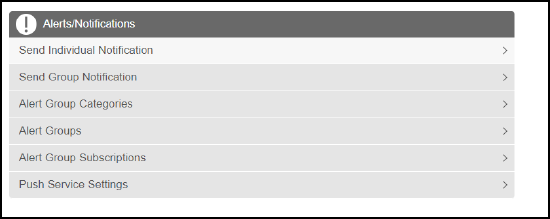campusM 2019 Release Notes
Known Issues
- In the preview environment, where WKWebView is enabled, a user can capture photos when the camera permission is denied. This will be fixed in July release.
- In the preview environment, where WKWebView is enabled, in personalization, arranging tiles on iPhone X moves the Reset and Done button locations, placing them beneath the header. This will be fixed in July release.
Known Issues
- The Creative Studio does not function using IE 11 due to lack of browser support for the Javascript framework used to provide the enhanced user experience found within Studio.
- Some Pocket Guide pages/content is not loaded and cached locally on the iOS app, which means this content will not be available offline for the end-user, even if they have visit the pocket guide page previously. This will be addressed in the March 2019 release.
Known Issues
- The Right Side Gutter % of Screen property set at the menu option level only works with AEK pages.
- The Show More option does not appear on the first load of the timetable page on iPads
- Searching for a notification displays the current date and time in the column instead of when the notifications were actually sent.
Developments
Import Content and Formats from Existing Webpages
December 2019
To enable customers to quickly create campusM content pages from existing web pages, we have added an Import HTML function that can import the base code from a page URL or file and ingest it, displaying the page within the campusM Creative studio Page. The content is then available to edit further and publish to your end-users through the campusM App.

Creative Studio Editor Permissions
December 2019
To improve consistency when transferring content management to other administrators, we created a new permission within the App Manager User Permissions to restrict creating pages to be based only on your institutionally-generated templates. This ensures that App Administrators with this permission can only create pages based on your institutional templates, enhancing consistency for your end-users.
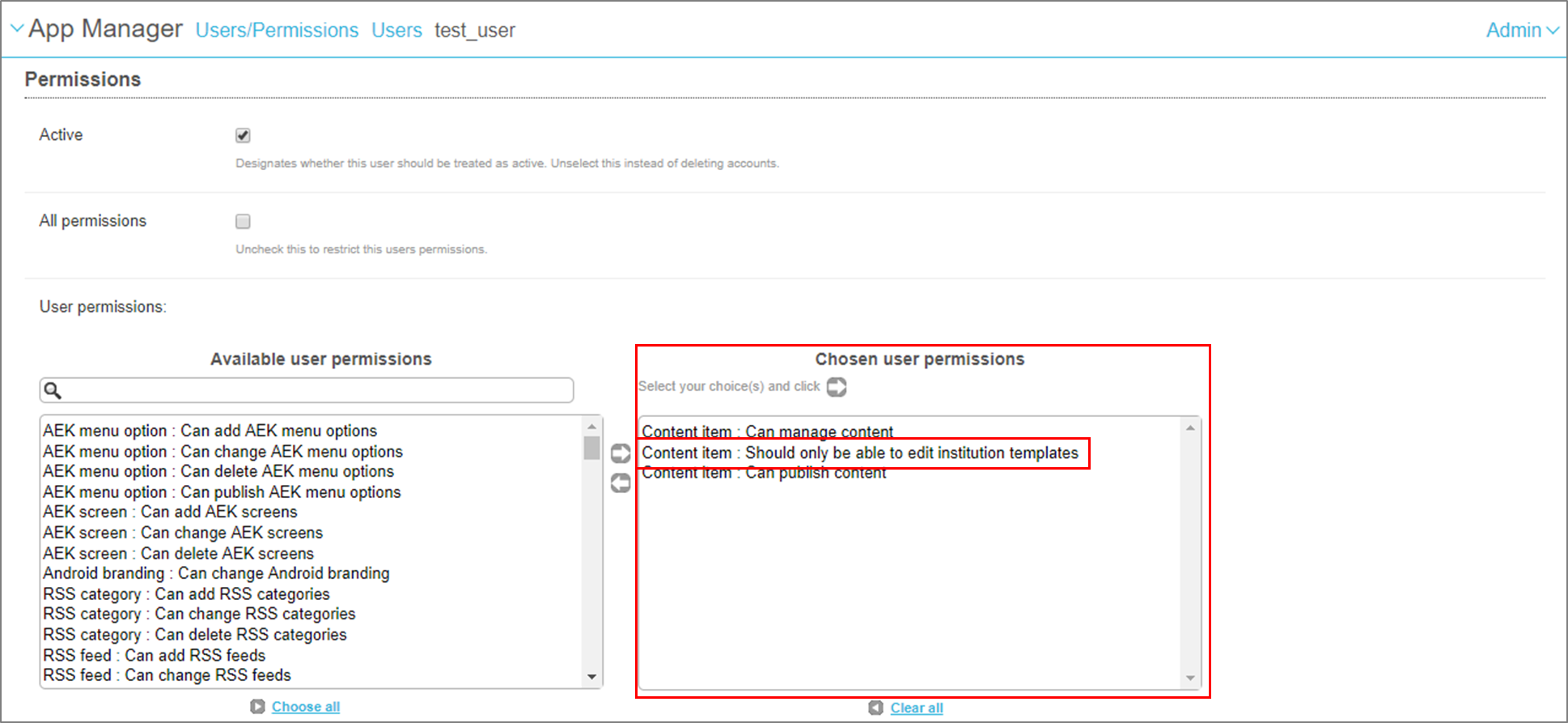
This permission also restricts the Creative Studio editor, removing the ability to add additional page component or to edit the code or save the page as a new template.
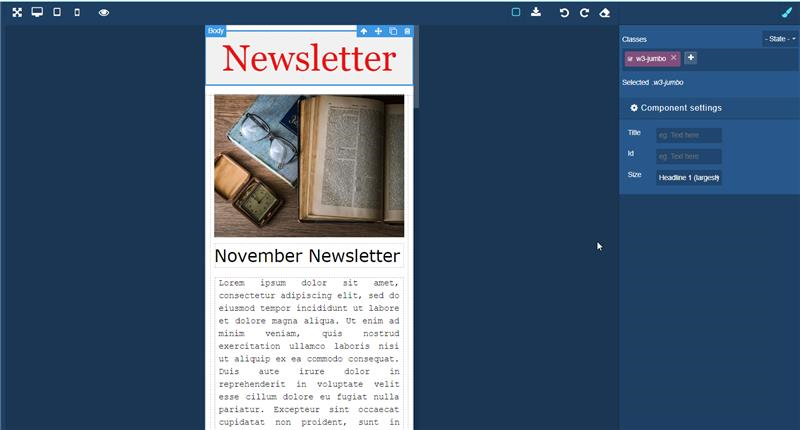
Bulk Export and Import of Positions
December 2019
To facilitate bulk management of location details within the campusM, we now provide the ability to export the Maps, Categories, and Positions to an Excel file. You can then add new or updated information to this file and import it back into campusM. This is visible only if you have permissions to manage Maps and Positions for your app.

AEK Native
December 2019
We have now consolidated the recent AEK enhancements that give increased access to native features within your AEK projects. These enhancements include:
These functions were added to aek-libs and documentation on their use is available in NPM.
Portal Style – App Header Image links to Home Page (SF Case: 00717773)
To enhance the general navigability of the campusM Web App, we added a new property in the Portal Style configuration that enables the header image / logo to link back to the app home page.
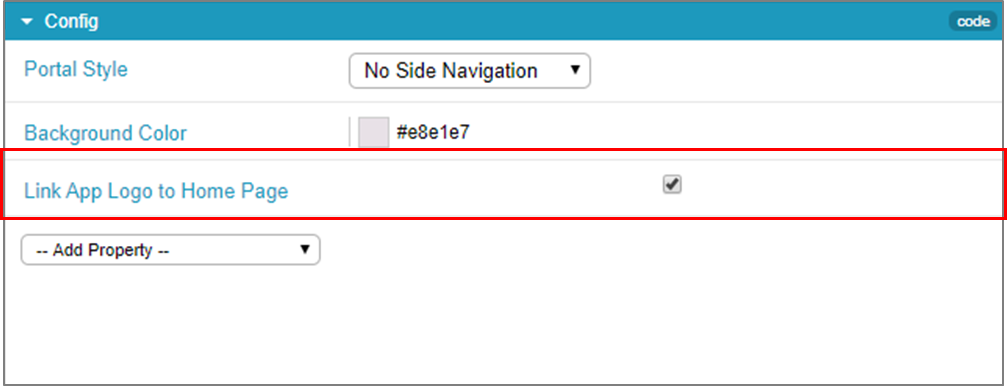
Insight API
December 2019
To enhance the legibility and usability of the Insight API, we enriched the data output to include both Menu Option and Hit Descriptions to ensure that the data is legible.
- Microphone Support (Recorder) – the ability to access and record sounds from the device’s microphones within your projects
- Beacon Support – the ability to retrieve an array of visible iBeacon (a Bluetooth-based micro location technology) identifiers (UUID, Major and Minor values), along with the signal strength and associated position
- GPS Support – the ability to retrieve the device's GPS details, including longitude, latitude, altitude, and accuracy
Accessibility Enhancements
December 2019
We had our final push for WCAG accreditation and were issued a notification for the WCAG AA 2.1 reaccreditation process. You can find details of the independent accessibility audits with the following links:
- For Android: https://knowledge.exlibrisgroup.com/@api/deki/files/77192/CampusM_VPAT_and_WCAG_(Android)_October_2019.pdf?revision=1
- For iOS: https://knowledge.exlibrisgroup.com/@api/deki/files/77191/CampusM_VPAT_and__WCAG_(iOS)_October_2019.pdf?revision=1
- For the Web: https://knowledge.exlibrisgroup.com/@api/deki/files/77193/CampusM_VPAT_and_WCAG_(web)_October_2019.pdf?revision=1
Accessibility Enhancements
November 2019
As part of the preparation for the campusM WCAG AA 2.1 reaccreditation, we have made a number of enhancements to the labeling of interface elements and voice over metadata to improve the experience when using screen readers or other accessibility technologies on the native apps and the Web app.
campusM Attendance
October 2019
campusM Attendance is now available for general release. Request the service change to have campusM Attendance made available to your institution.
campusM Attendance has been designed and developed to make capturing class attendance easy, and at the same time provide the confidence your institution needs that student check-ins are valid. Using a unique multifactor validation process, our highly configurable attendance function allows you to select from One Time Code, Geolocation, and iBeacon-based crowd validation, delivering an intuitive experience for both students and staff that is resilient and reliable.
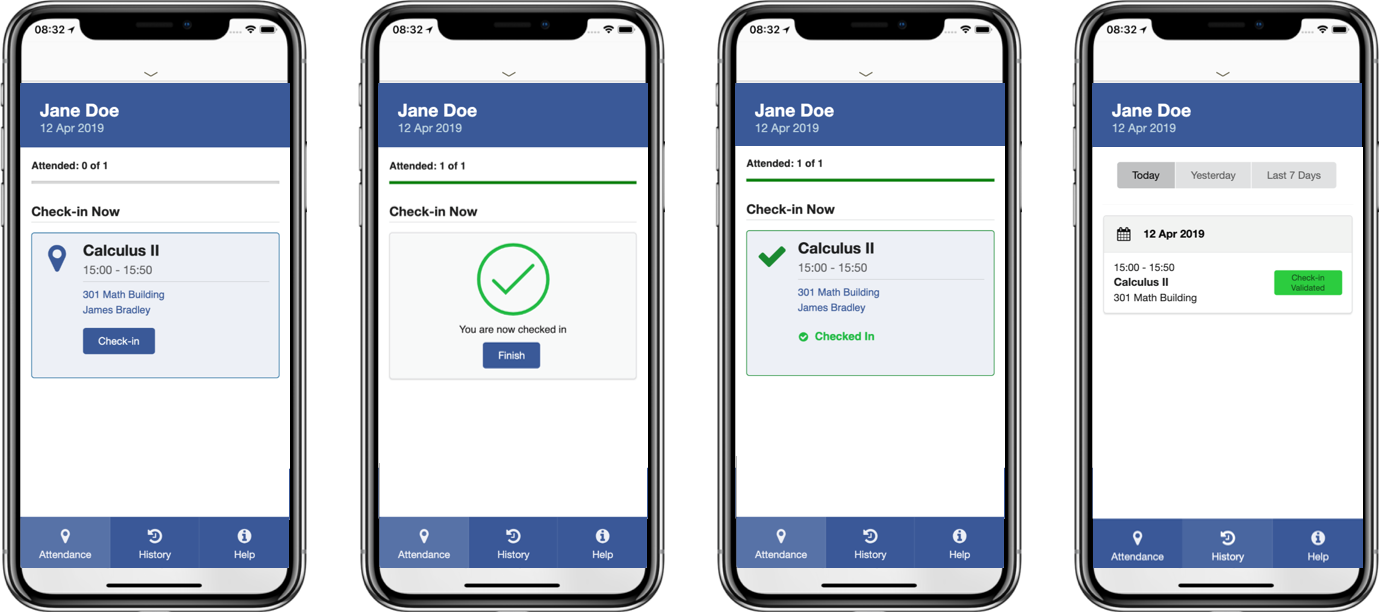
For more information about campusM Attendance features, see Attendance.
For information on configuring campusM Attendance, see Managing campusM Attendance.
The following prerequisites are required to enable Attendance:
- Student Personalized Time Table: Your Student Information System must be configured with all class schedule information and integrated with campusM. The information should include the class title, start and end times, and location if using Geolocation as a check-in type. Each class should have a unique EVENT ID. This must be per event, (not per course, series of classes, etc.). The EVENT ID must match the same event on the staff timetable. For more information, see campusM Timetable.
- Staff Personalized Time Table: This time table must be available to lecturers if you want them to be able to check in students. It must contain the lecturer's class schedule and the list of students for each class. Each event (class) must have a unique EVENT ID. This must be per event, (not per course, series of classes, etc.). For more information, see campusM Timetable.
- To allow lecturers to check in students, you must configure a student Retrieve Attendees service. For more information, see Retrieve Attendees for Events.
- If using geolocation, each class location (longitude and latitude) must be configured for all location references in the student and lecturer timetables.
Open a Salesforce ticket to register your interest in deploying the prerequisite services and delivering attendance for your institution.
campusM Web App Timetable Display Enhancements
October 2019
Following last month’s enhancement of native timetable information display, we implemented this within the campusM Web app. This enhancement improves the way long descriptive text is displayed within the timetable. If the timetable details (start and end time, description etc.) exceeds 15 lines, the descriptive text is hidden until the user clicks show more where upon the interfaces expands the detail shown on the mobile screen. This provides an improved experience for your end users.
Creative Studio – New Templates
We added some additional templates to further accelerate your creativity and develop engaging content. These templates include:
- Article Template
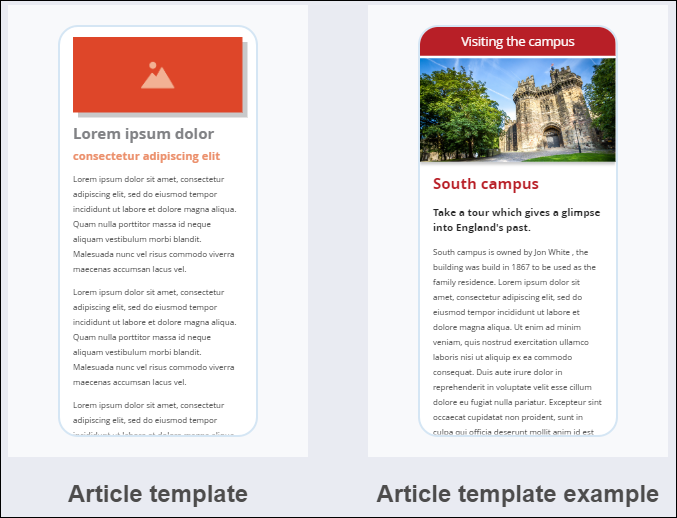
- Card Template
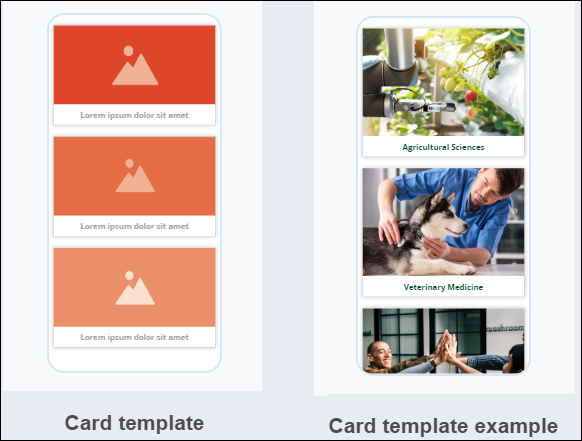
- Post Template
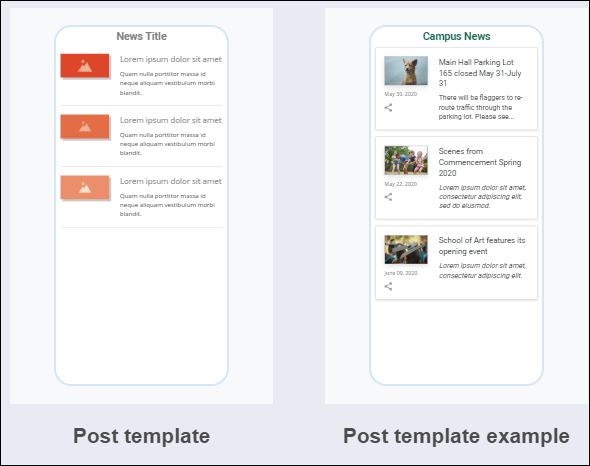
- Information Template
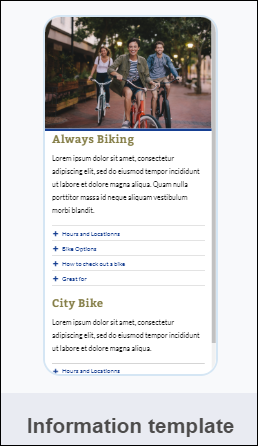
Enhanced App Sharing on iOS
October 2019
We enhanced the way that students can share links to and information about the campusM App on social media, email, and other channels, making use of the iOS share functions. To share the app, users can go to the App settings, select Tell friends about app and select a preferred sharing option.

Accessibility Enhancements
October 2019
As part of the preparation for the campusM WCAG AA 2.1 reaccreditation, we made a number of enhancements to the labeling of interface elements and voice over metadata to improve the experience when using screen readers or other accessibility technologies on the native apps and the Web app.
iOS 13 Developer Beta Crash Fixes
October 2019
As part of our preparation for the coming release of iOS13 (planned for sometime in September), we have been testing the Developer Beta versions that have been made available by Apple.
We identified and resolved several issues with the current version of the campusM app. These issues have been resolved in this release and also patched for the August release. Customers have been advised that we will be releasing the August update for iOS and Android for all customers, unless requested otherwise.
To find out more about preparing for the coming iOS update, see Preparing for iOS Updates.
iOS Webview Upgrade
September 2019
We upgraded to WKWebView, the latest version of WebView, that enhances the end user experience and stability of the app generally.
Why Did We Upgrade to WKWebView?
What Did We Change in the App?
- SSO login page
- CMauth login page
- campusM Homescreen
- AEK screens
Portal View
September 2019
With an increasing number of customers using campusM as their primary student portal for both mobile and on the Web (desktop, laptops etc.), we have redeveloped the Web app homescreen to provide a more traditional portal-like view, with left-hand side navigation, bread crumbing, and full-page display.
- Text format and alignment
- Text Size and Weight
- Menu color and spacing
- Icons and their placement
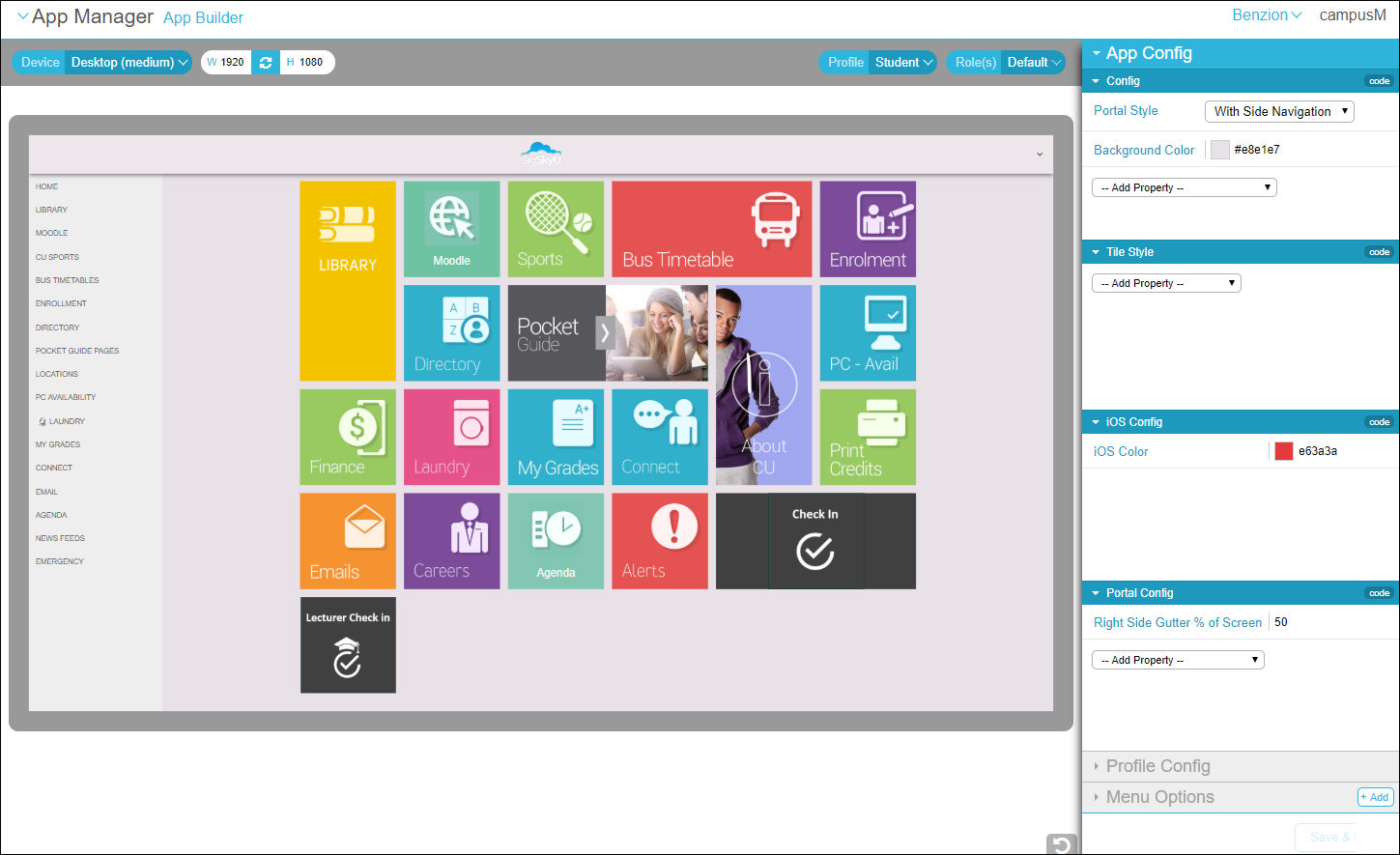

Notification Center Enhancements
September 2019
We have made a number of enhancements to our new Notification Center:
Notification Preview
If you hover over the notification title, a preview of the message title and body appears to make it easier to check the notification content in the Notification Center:

Notification Edit and Resend
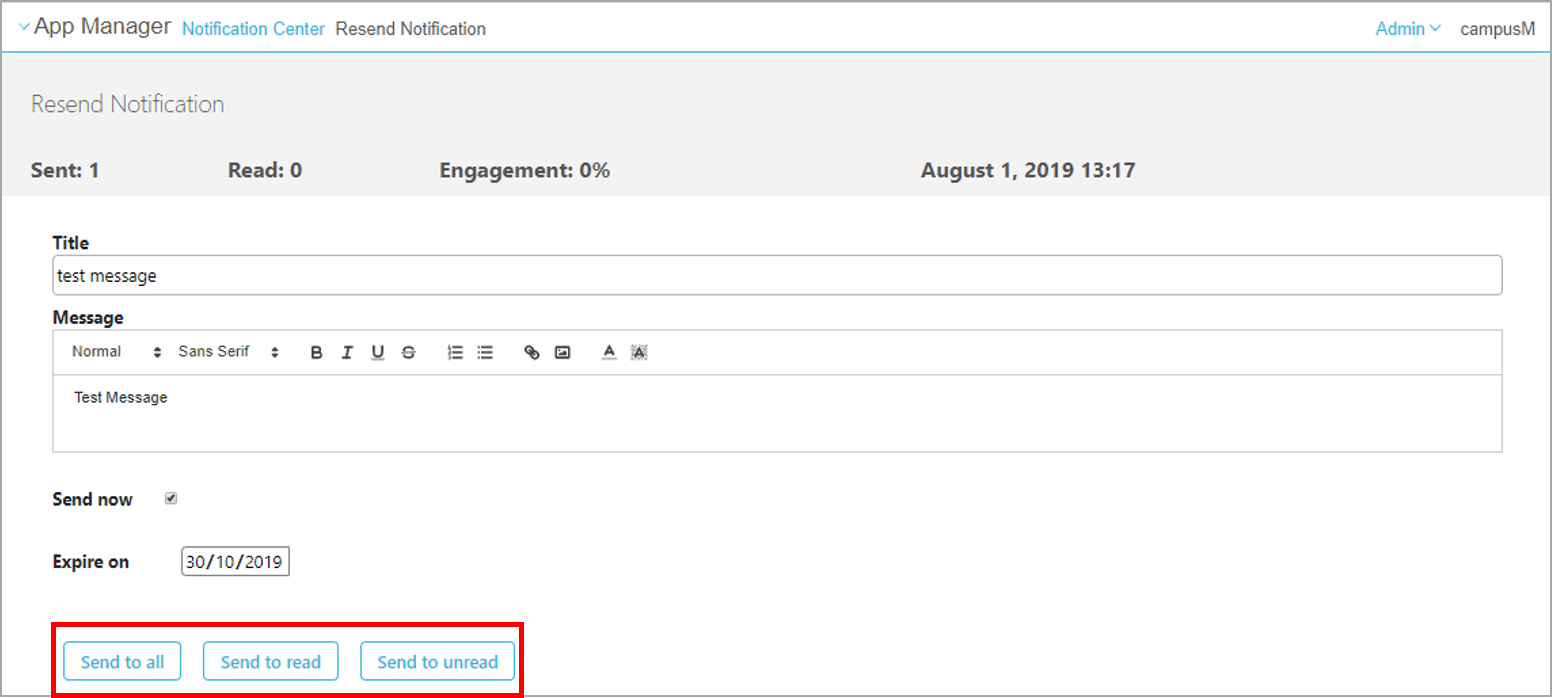
Scheduled Notification Delete
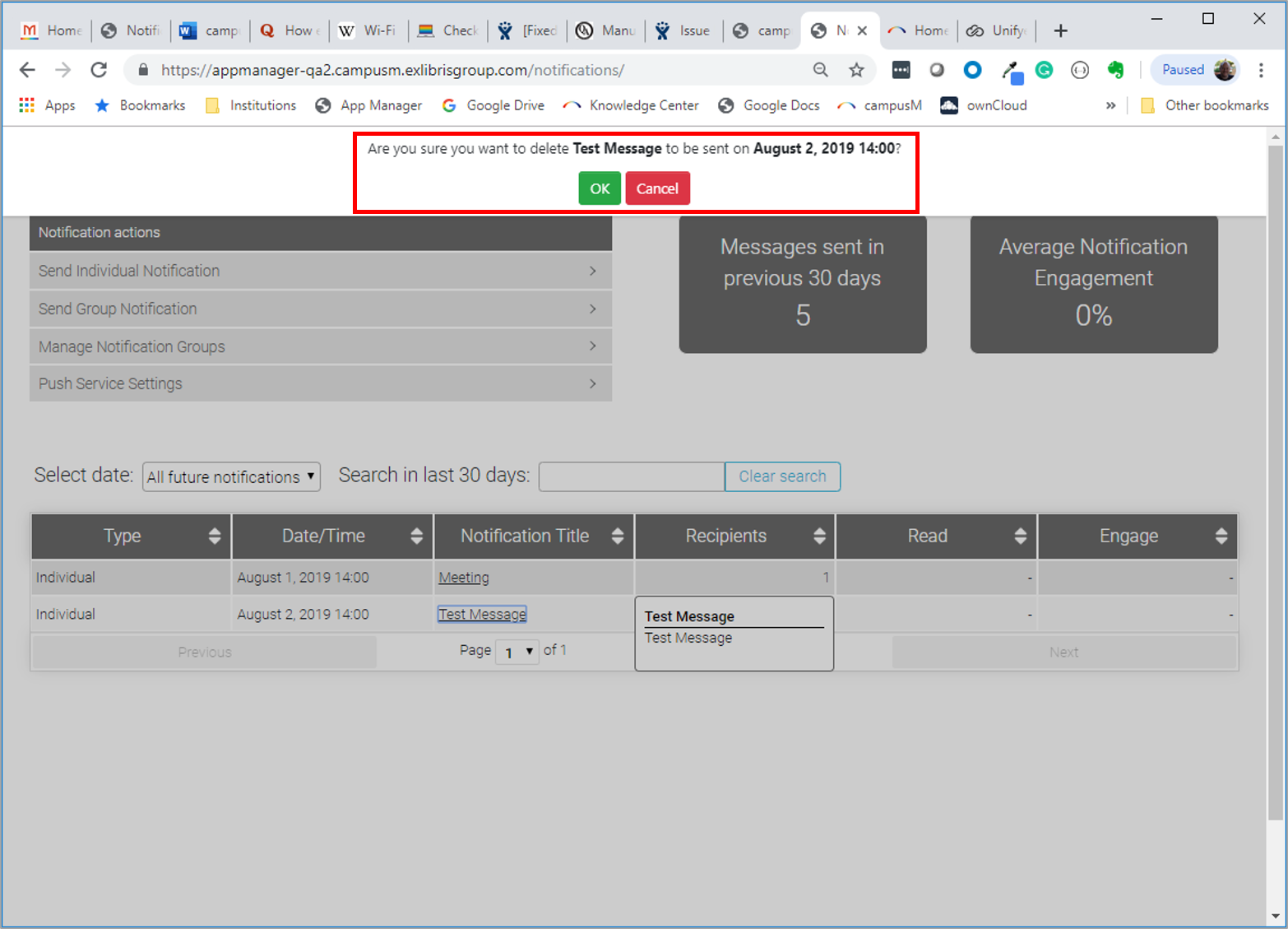
Notification Expiry Date
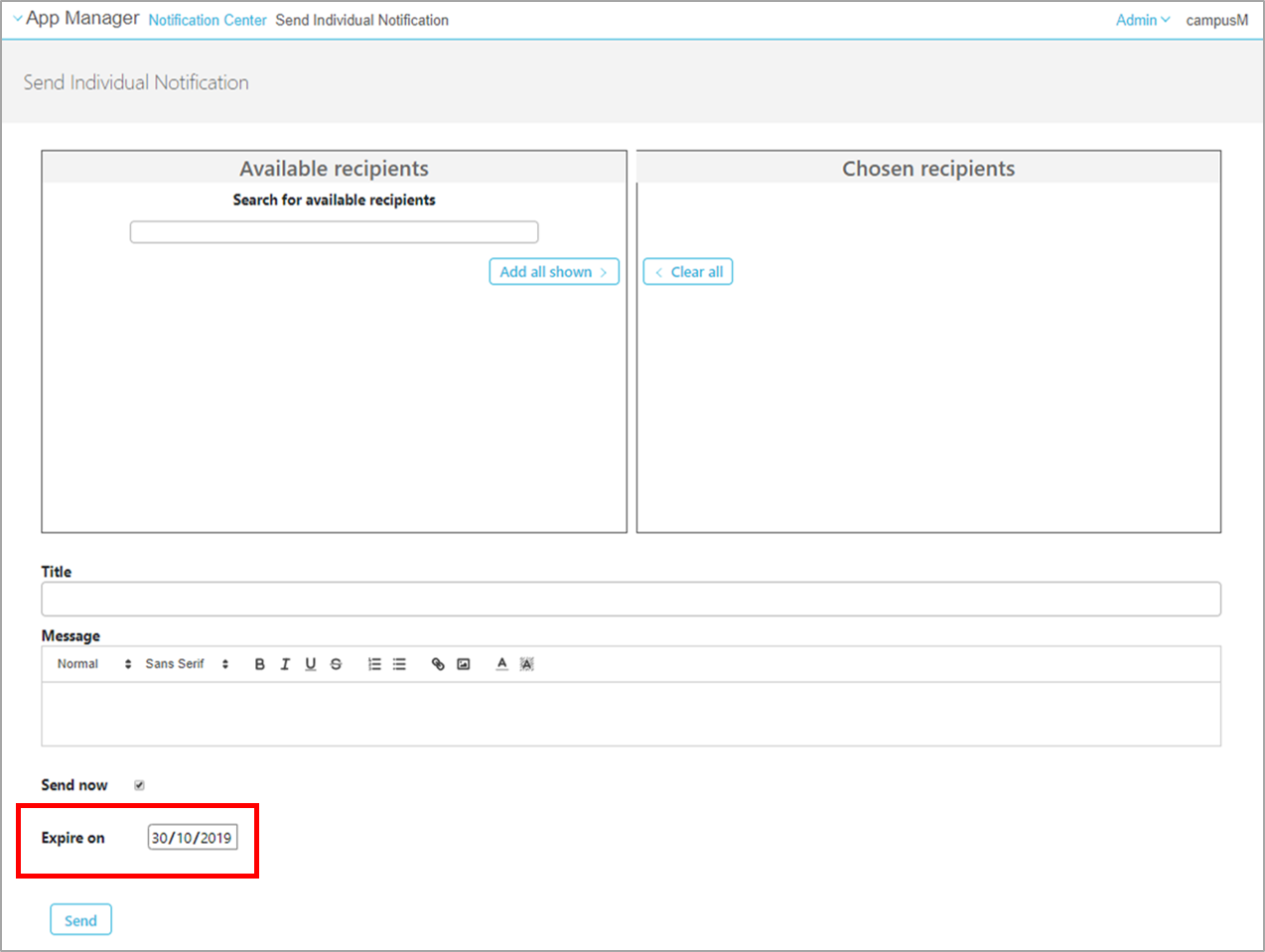
campusM Native Timetable Display Enhancements
September 2019

Accessibility Enhancements
September 2019
As part of the preparation for the campusM WCAG AA 2.1 reaccreditation, we have made a number of enhancements to the labeling of interface elements to improve the experience when using screen readers or other accessibility technologies on the native apps and the Web app.
iOS 13 Developer Beta Crash Fixes
September 2019
As part of our preparation for the coming release of iOS13, we are testing the Developer Beta versions that have been made available by Apple.
We identified and resolved several issues with the current version of the campusM app and resolved these in this release. This was also patched to the August release. Customers were advised that we are releasing the August update for iOS and Android for all customers unless requested otherwise.
To find out more about preparing for the coming iOS update, see Preparing for ios Updates.
iOS Webview Upgrade
August 2019
We upgraded to WKWebView, the latest version of WebView, that enhances the end user experience and stability of the app generally.
Why Did We Upgrade to WKWebView?
What Did We Change in the App?
- SSO login page
- CMauth login page
- campusM Homescreen
- AEK screens
AEK Native – iBeacon Access
August 2019
This month sees the introduction of another component of our AEK native development theme, as we expose access to visible iBeacons on the native apps in your AEK projects. The beaconData callback action available in AEK allows you to retrieve the beacon parameters (UUID, Major and Minor, Received Signal Strength Indicator [RSSI]) along with the associated position information (if configured in the app).
AEK Native – Microphone Access Enhancement
August 2019
Following its initial release in April 2019, this release sees a minor enhancement to the gain and sensitivity of the microphone access, improving the quality of the captured audio. Access to the microphone within AEK projects using the following campusM URL mechanism is available for iOS.
- campusm://micRecStart -- Starts the Microphone recording
- campusm://micRecStop -- Stops the Microphone recording
Profile Screen Interface Alignment
August 2019
The icons used on the Profile Selection screens for the iOS and Android apps have been made consistent for the various authentication methods.
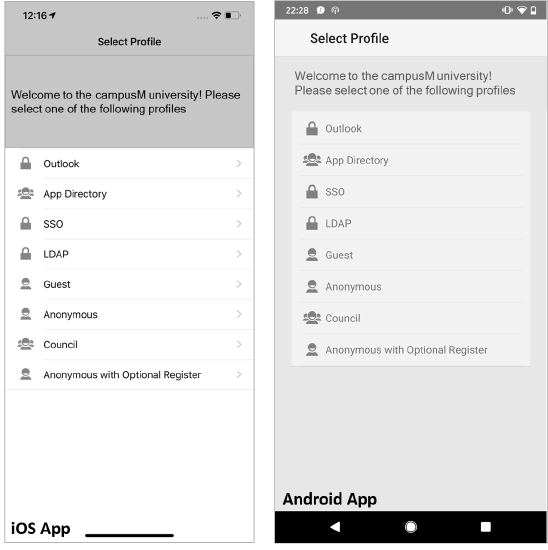
Automated App Submission
August 2019
Alert Group/Role Synchronization Enhancements
July 2019
With the increased focus on providing a compelling experience for ALL users, the development team have been making a number of enhancements in support of assistive technologies and our continued compliance with WCAG.
This month we have made the following enhancements in this area:
- Improved the way that the web app works with Screen Readers and when navigated using only the keyboard.
- Improved the contrasting on the iOS tab bar
- Improved accessibility descriptions for navigation and action buttons
- Improved usability for end users when the user focus changes as items are selected
campusM Accessibility
July 2019
As part of the enhancements to the campusM Notification Center, we have enhanced the synchronization between alert groups and Roles where they have been aligned as part of the Group Alert Category setup.
The Alert Group user subscription will now be updated and synchronized as your students’ roles are changed manually or updated via RoleSync.
Notification Center – Scheduled Notifications
June 2019
As part of our ongoing improvements for the notification center, we are introducing the option to schedule notifications from the app manager as a component of this release. This allows you to create notifications in advance of their sending and define a date and time for their release. It will be invaluable for managing engagement communications for your events or campaigns.
When sending notifications, whether for Individual notifications or to an Alert Group, a new checkbox is available, Send Now, which is enabled by default. To schedule the notification to be sent at a defined time, un-check this checkbox and set a date and time for the notification to be sent.
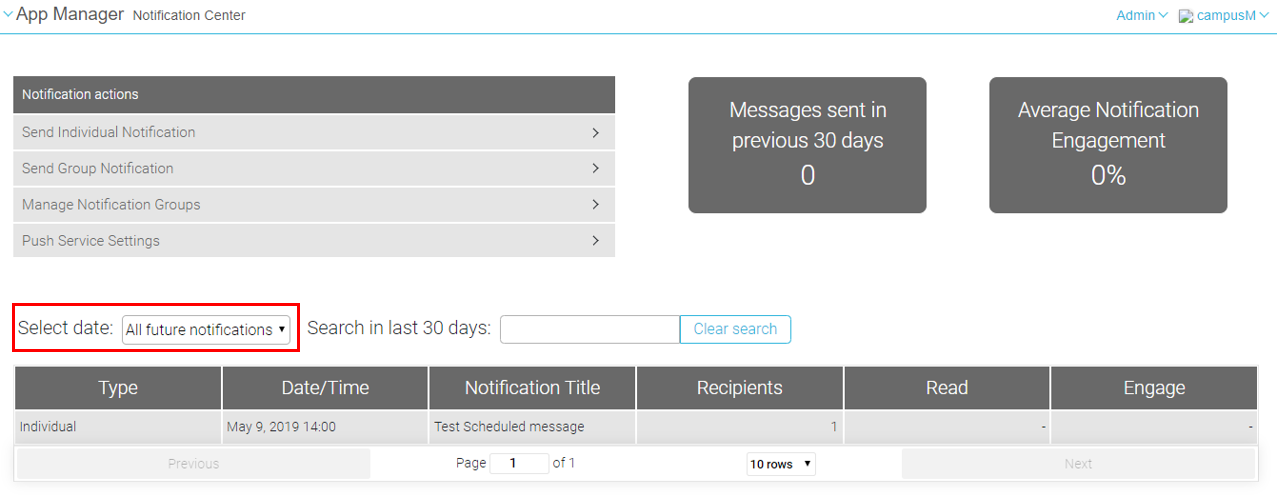
To view any future scheduled notifications that are yet to be sent, select All Future notifications.
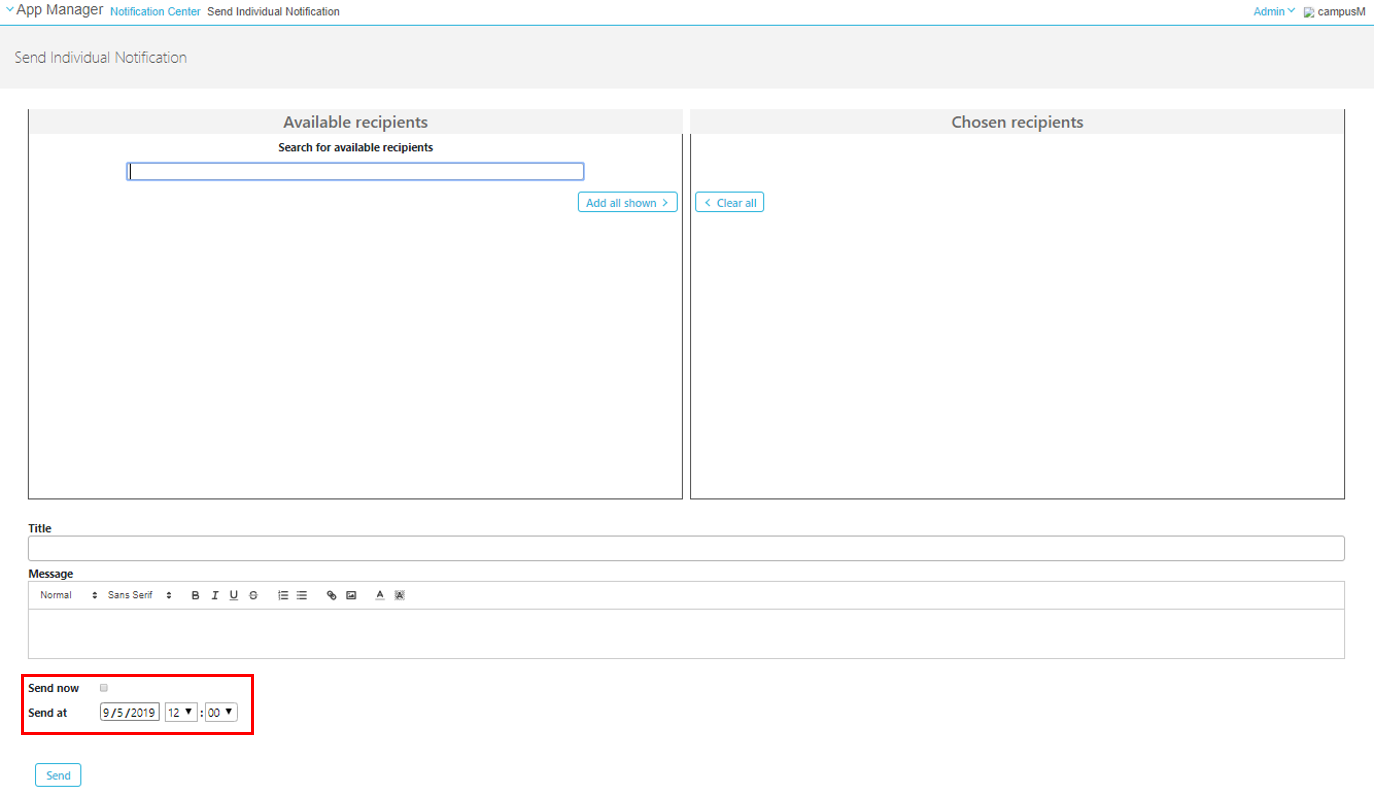
Creative Studio templates
June 2019
To allow institutions to devolve responsibility for creating and managing content to content owners in a controlled way that ensures consistency in experience and retention of the university brand, institutions can now create their own page templates within Creative Studio to use to create new pages. Used well, this can ensure consistency in structure, colors and designs throughout your content, whilst providing end users with a familiar look and feel across the application.
Administrators who have content item | Can manage content templates in Creative Studio permission can save created pages as templates. In a coming release, we will provide additional roles within App Manager that will restrict content owners to only using the institutional templates created.
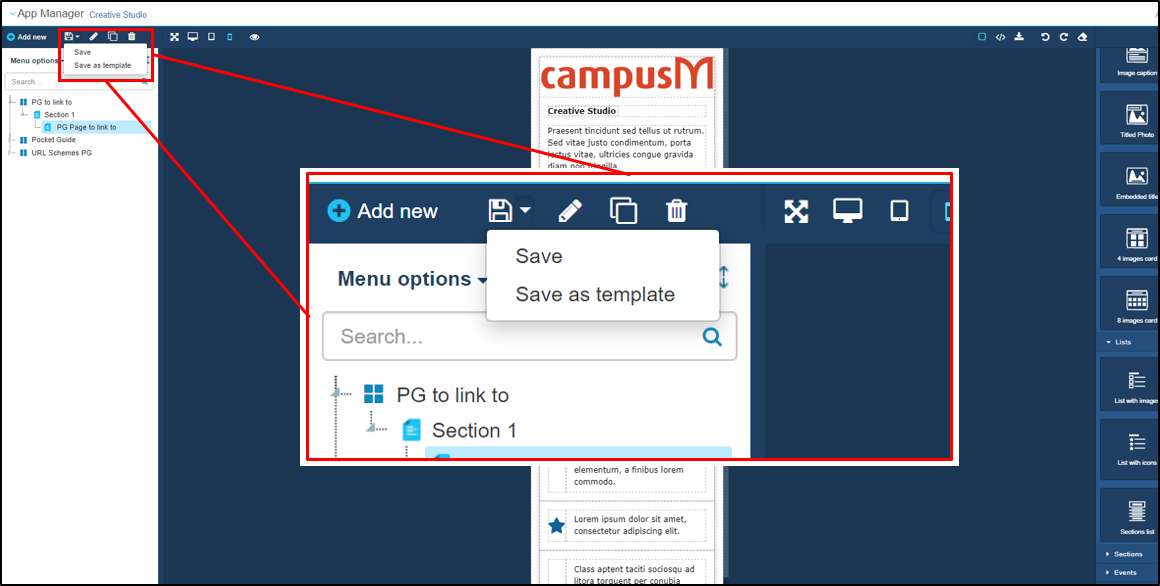
When creating a new page, the institution's templates appear under All and Organisation Templates tabs.
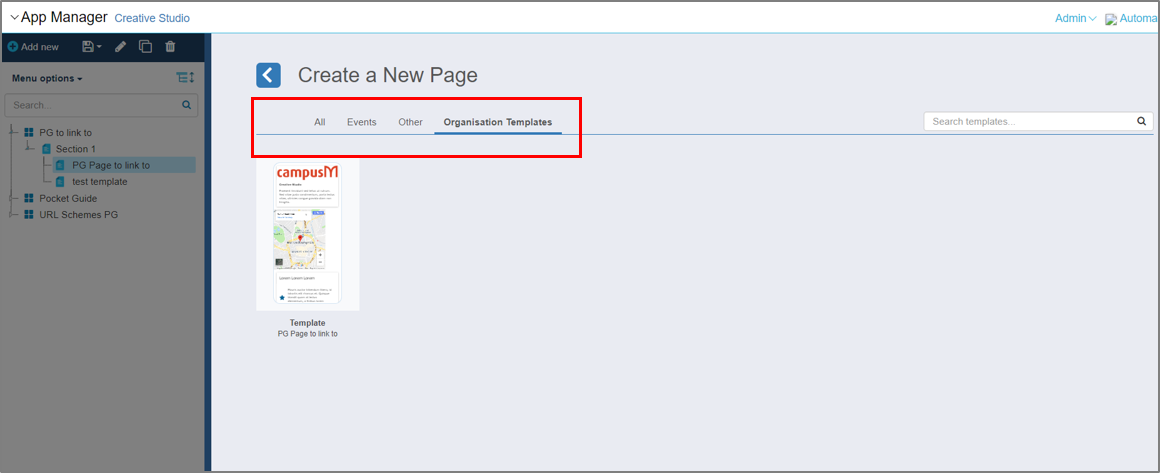
Template can be deleted, and the names can be edited from the templates page by hovering over the template and selecting the edit icon that appears.
Creative Studio HTML & CSS Editor
June 2019
In this release we have extended the page creation tool to provide a code editor that enables advanced content creators to edit and include HTML and CSS code part of their pages and templates. The code editor includes a WYSIWYG preview where any code change is reflected immediately onscreen, along with code completion to aid editors.

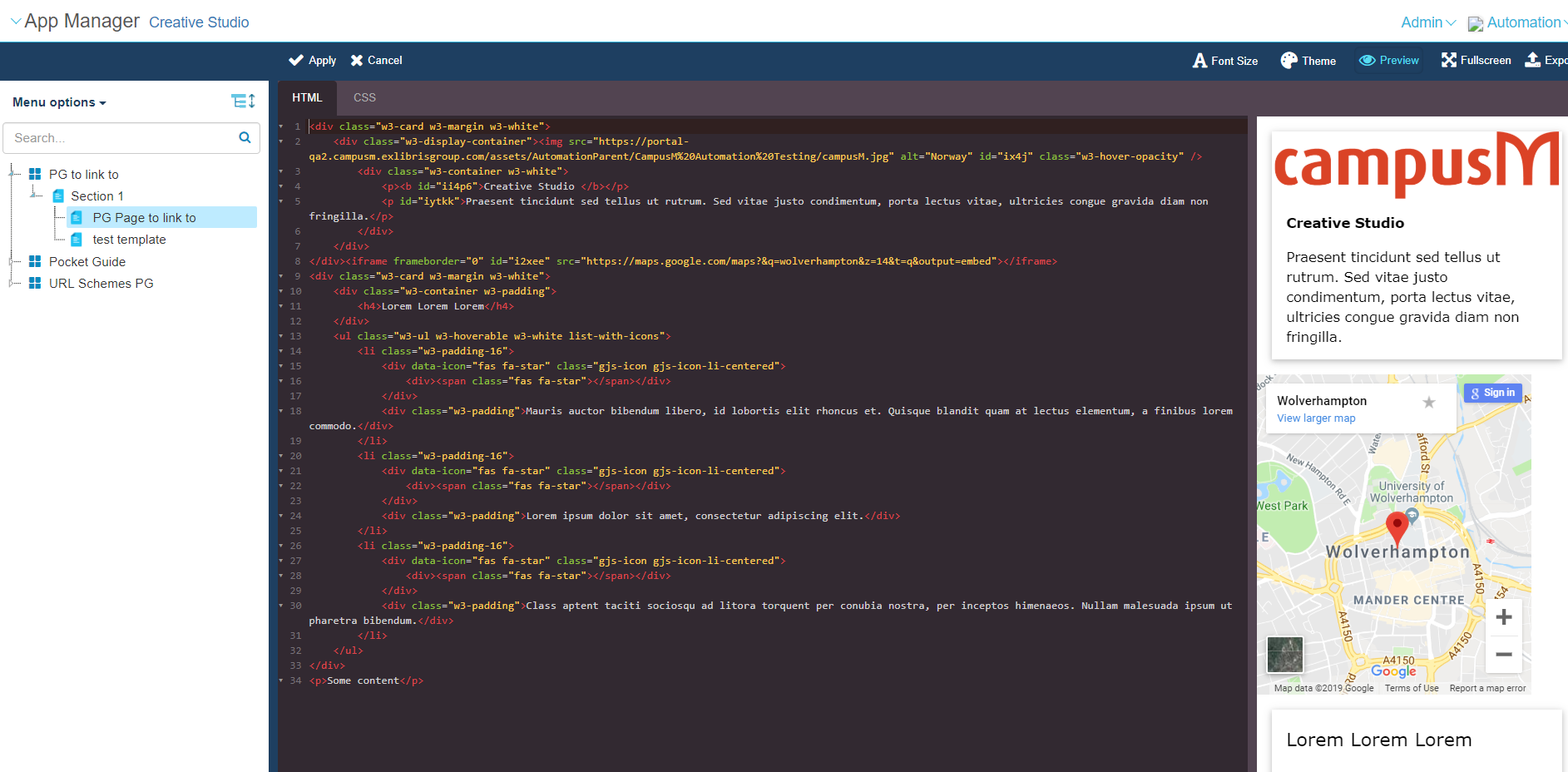
Creative Studio Improved Internal Linking
June 2019
We have enhanced the linking component within Creative Studio to provide the URL auto-complete found within other areas of App Manager, to aid with linking to internal pages and menu options within your app.

Adding an HREF is available either by typing the URL into the box above, or selecting the box to open the Create Hyperlink popup shown below, to help linking to internal pages, resources or menu options.

iOS Webview Upgrade
June 2019
UIWebView is a class used in many areas of the campusM iOS application that supports the view that embeds web content in the app.
We have upgraded to WKWebView, the latest form of this WebView that enhances the end user experience and stability of the app generally.
Given the scope of this change the impact that the migration to this new enhanced class may have, we will be reserving this change to Preview Apps ONLY for the next two releases (June 2019 and July 2019) to provide customers with ample time to preview the changes. We will then release to Production as part of the August 2019 release for iOS apps.
The following change will be available in the coming releases in the Preview environment and with August release will be also available for production.
Why did we upgrade to WKWebView?
Apple has officially deprecated the UIWebView since iOS 12. This means that it is not the recommend tool to show web content within app. Given the depreciated nature of the view, Apple could remove it completely from their SDKS without warning which would make it difficult to create apps against the latest build tools. Migrating to the new WKWebView removed this risk and at the same time provides better performance and compliant with the latest web standards.
What did we change in the app?
The current app UX relies heavily on web content that is dependent on the UIWebView. We are upgrading all the UIWebViews used within the app to the new WKWebView over the coming two release. As part of the June release, the following are the main areas that have been upgraded:
- SSO login page
- CMauth login page
- campusM Homescreen
- AEK screens
While all efforts have been made to test the impact of the changes and ensure the migration is painless, customers are asked to pay particular attention to the areas above (if applicable) during their Preview testing and report any issues or unexpected behaviors seen through Salesforce.
Notification Center
May 2019
Given the high usage of push notification used by customers to engage with end users, we have developed the campusM Notification Center which provides enhanced visibility for app administrators on the levels of engagement for the messages being sent, whilst providing additional functionality to improve communication with the unengaged users.
As part of this initial release of Notification Center, we are providing the notification Dashboard where app administrators can view the number of notification sent in the last month alongside the percentage of users that has read the notifications.
On initial opening, the last days’ worth of notifications are shown, and search/filters are provided to be able to locate and display notifications sent over the last 30 days.
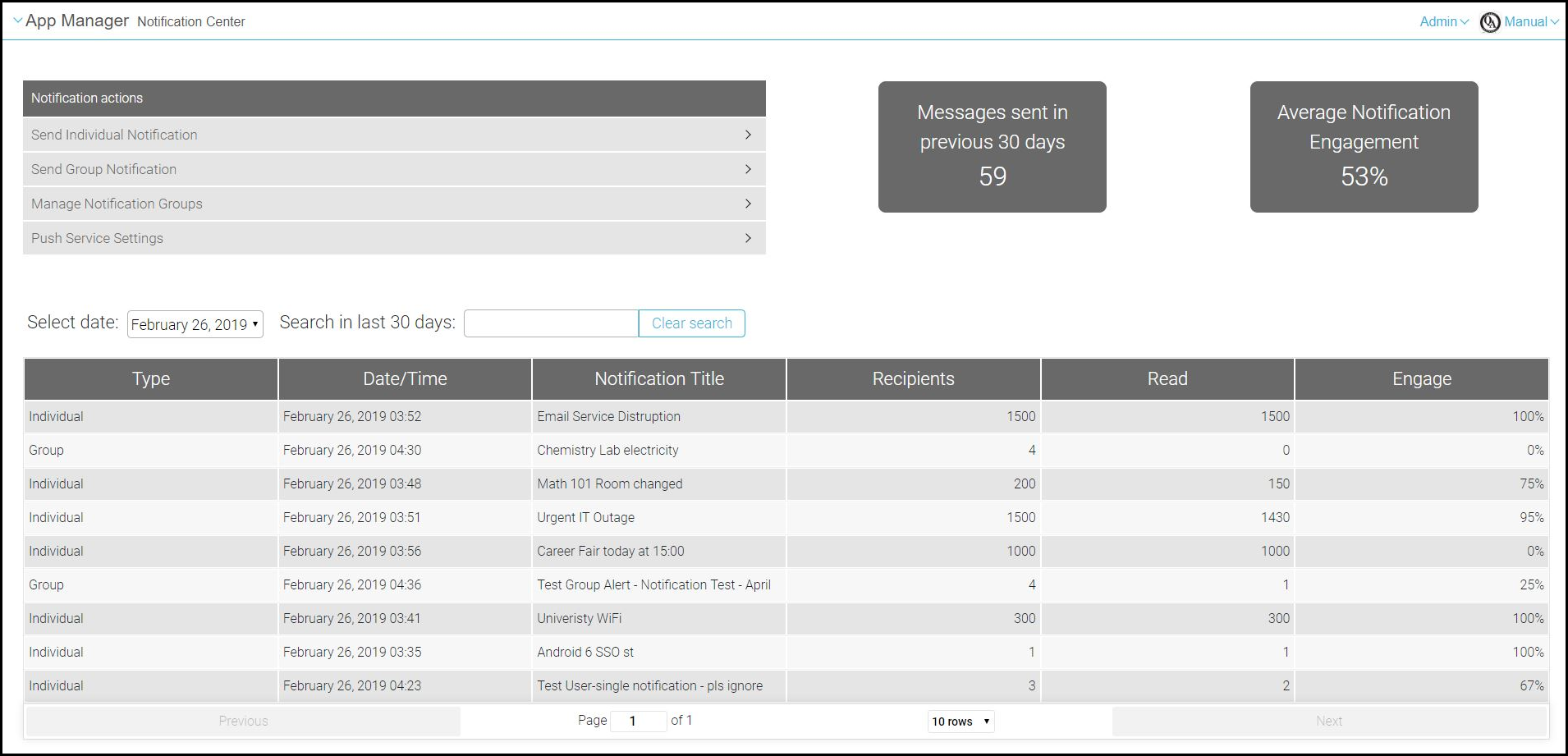
As part of this month’s deployment, we have improved the workflow for managing alert groups, combined the different screens to manage the group subscription into one.
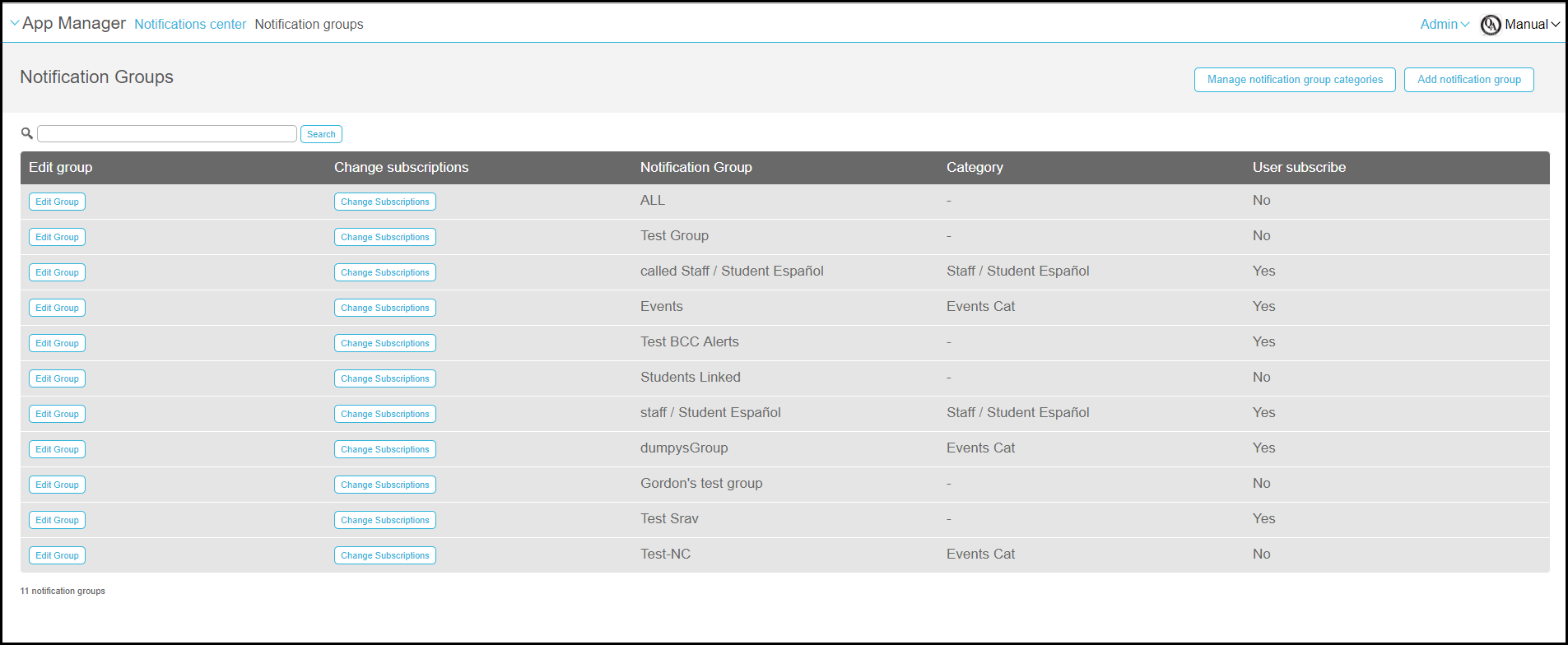
In the coming months we will continue to enrich the dashboard with additional functionalities, such as scheduled notifications and the option to resend notifications to those that have/haven’t read the initial message.
Biometric Lock
April 2019
As part of our ongoing commitment to providing a secure app that respects user’s privacy, we have provided end users with the ability to enable a biometric lock for their app. If enabled by the user, this feature will prompt the user for their devices selected biometric prompt when they go to the app, preventing unauthorized access their personal information and experience.
After this release has been installed/updated on the user’s device, they will be asked whether they would like to enable the biometric access restriction. If enabled, the user will be prompted for their biometrics anytime they access campusM on their native device.
The prompt for enabling the biometric lock is enabled by default to all profiles and users (except for anonymous and council profiles) and the student will see the following prompt to enable the lock:
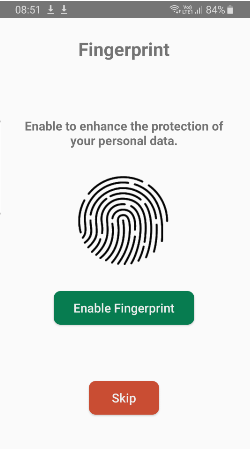
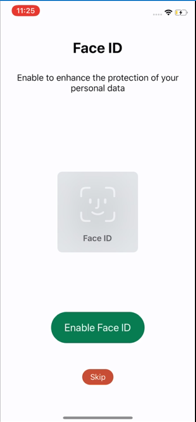
The access lock is dependent on the device settings for enabled biometrics - so for users that have enabled fingerprint/TouchID on their device, this will the selected biometric used to access campusM (if enabled). Likewise, if the end user has enabled FaceID, then this will be the requested biometric. For older devices, the ability to use the PIN/ passcode is available.
For iOS the biometric options are Face ID and Touch ID (Fingerprint) and the Fall-back options will be the PIN.
For Android the biometric options are Fingerprint, Face ID, Iris. The Fall-back options will be PIN, Pattern, Password, PIN.
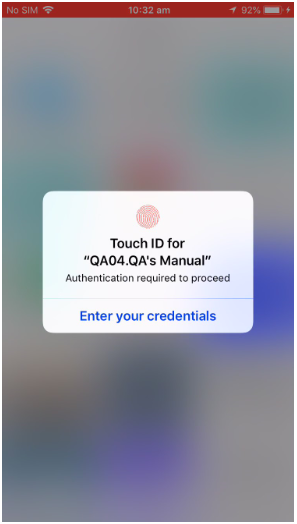
Users can enable or disable the functionality anytime within the App Setting.
Smart App Banners - Promoting use for the app from a website on mobile
April 2019
As part of our mission to ensure users have the best campusM experience available to them, we have added Smart App Banners that prompt users to the availability of the native app if the user is using the web app on their mobile device.
The Smart App Banner will prompt the user to download the app with a link to the application in the App store, for iOS also in the case where the user already has the native app installed, they will be redirected to the enhanced native app experience.
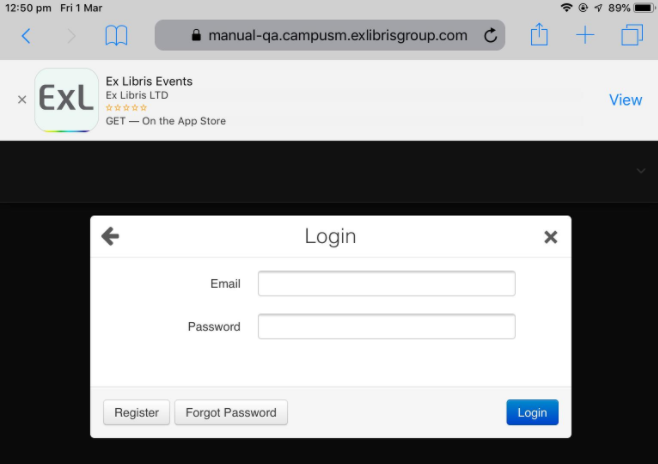
In order to have the Smart App Banner functioning and redirecting to the correct app listing, the iTunes URL and Google Play URL should be entered in their App Settings-> App configuration

The banners will be shown only on the devices default browsers (iOS banner will be shown on Safari and Android banner will be shown on Chrome), banner won't be shown after dismissed.
Native microphone use enabled for AEK
April 2019
To provide customers with enhanced access to native functionality within the Application Extension Kit (AEK) projects, we have exposed access to the microphone within these projects using a new campusM URL mechanism to use in iOS to allow AEK pages to record audio from the native app.
campusm://micRecStart -- Starts the Microphone recording.
campusm://micRecStop -- Stops the Microphone recording.
For web and Android this can be done by HTML5.
AEK 2018 SDK Update - React16
March 2019
 As part of this month’s release, we are making the AEK SDK update (previewed in December 2018) available to all. This update has enabled us to refresh and upgrade many of the core components of the SDK, adopting new standards and the latest stable versions of the supporting framework.
As part of this month’s release, we are making the AEK SDK update (previewed in December 2018) available to all. This update has enabled us to refresh and upgrade many of the core components of the SDK, adopting new standards and the latest stable versions of the supporting framework.
One of the new key areas that have been upgraded is the React version – from React 15 to React 16. This provides for a number of key enhancements including:
- Fragments
- Error Boundaries
- Portals
- Reduced File Size
- New Core Architecture (Fiber)
For more details, see https://reactjs.org/blog/2017/09/26/react-v16.0.html
We have also updated the following libraries to the latest. These include:
Babel - Updated from version 5 to 7
This will allow a user to use the latest code techniques as well as taking advantage of the ongoing file reducing brought in by Babel. You can see all the updates and new features in Babel 7 here https://babeljs.io/blog/2018/08/27/7.0.0
Eslint- Updated from version 1 to 5
This allows for a better linting structure. With this release we are also adopting a new rule set to allow for cleaner code.
Webpack – Updated from version 1 to 4
This allows for tree shaking and for better structure for how the code is packaged. We have removed certain steps but have also added in support for new loaders for files as well as scss files.
Lodash – Updated from version 3 to 4
This again allowed for tree shaking which will minimize package size as well as new functions from this library.
AEK Test Automation
With the introduction of JEST (https://jestjs.io/) you will be able to automate your AEK testing. Not only will this help with testing but allow you to always make sure that your projects are working 100% for a more stable project
App Manager Homepage Update
March 2019
As part of our continued mission to improve the user experience for both end-users and app administrators, we have updated the App Manager Homepage with a new, fresh look. This includes refreshing the icons for each App Manager component as well as adding in a friendlier, more engaging welcome message.
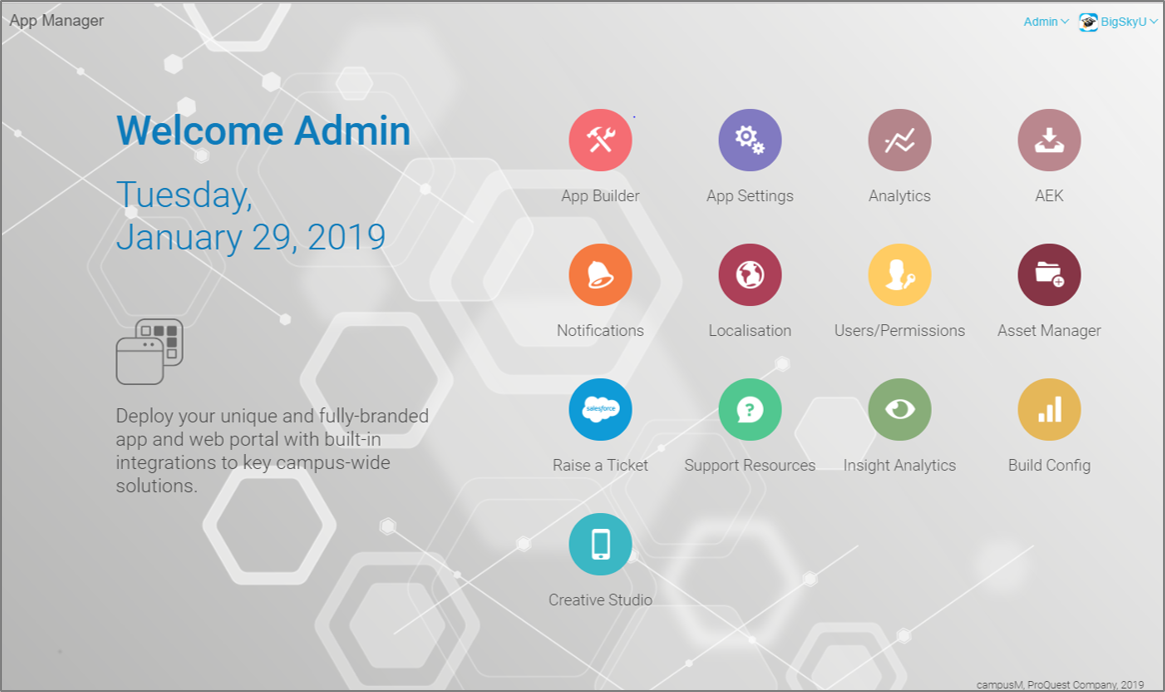
Android Back Button Behavior
March 2019
To improve the consistency and legibility of the apps, we have implemented a change to the behavior for the hardware back button (located at the bottom of the phone) and the software back button (in app, at the top of subpages within campusM) used within the Android app.
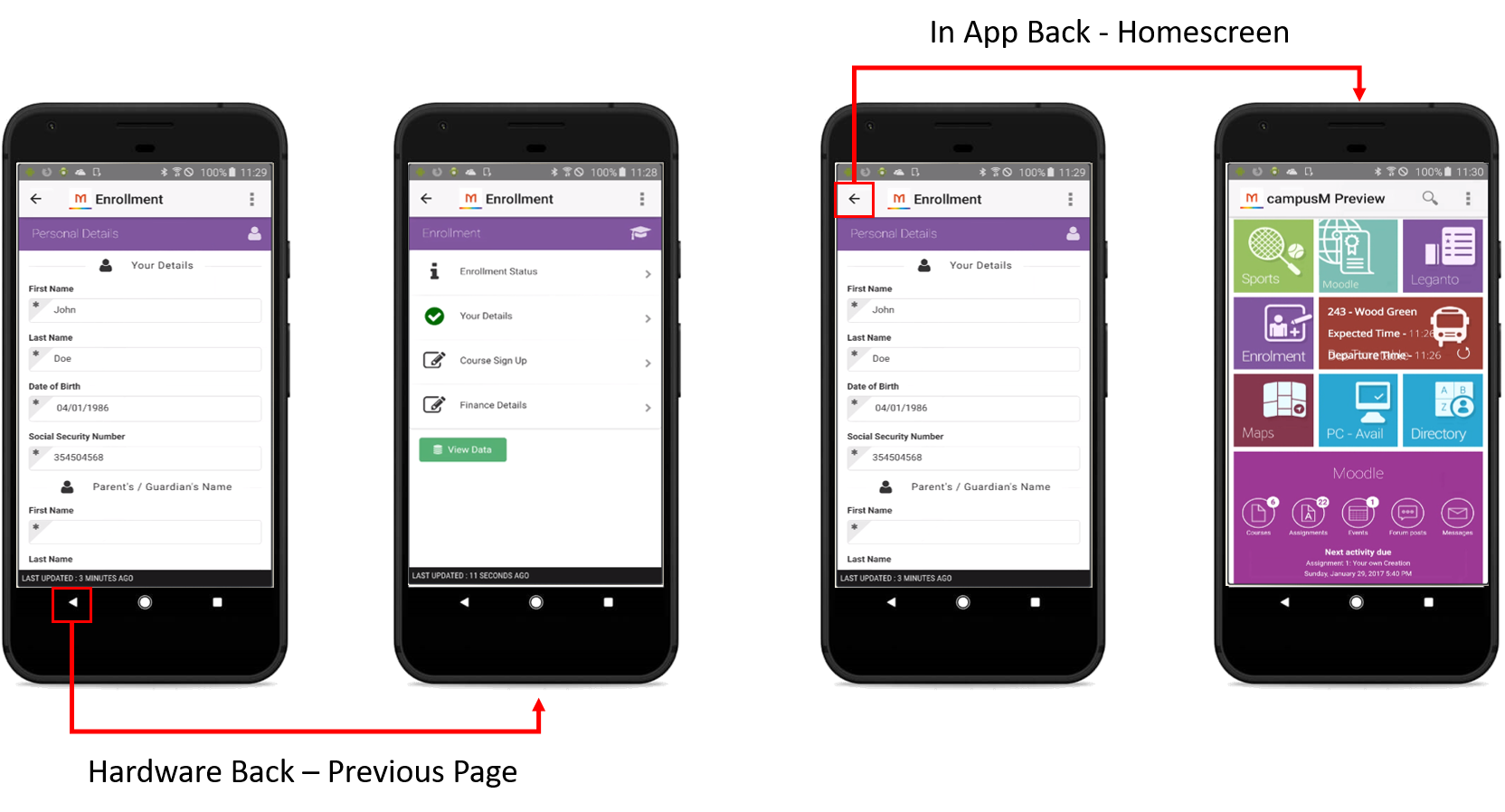
campusM Creative Studio
February 2019
The campusM Creative Studio allow institutions to design content and information pages on various topics within minutes. The Creative Studio uses a simple drag-n-drop interface, as well as out-of-the-box templates to ensure the creation, design, editing and publishing processes are intuitive and speedy.
In addition, the WYSIWYG (what you see is what you get) interface enables non-technical content creators to manage relevant and permitted materials, while the Creative Studio advanced features, such as CSS, code injections and more ensure the technical-capable staff can push the environment to its full extent.
Key features include:
- True drag and drop interface to enable all administrators to create engaging, great looking content in minutes.
- Templates to get your content started
- Many dynamic components to drag onto your page to render engaging multimedia content, such as images, videos and maps
- Backwards compatible with existing content
Find out more in our dedicated Creative Studio section within the Knowledge Center, Managing Creative Studio
External Link out Improvement for Android
February 2019
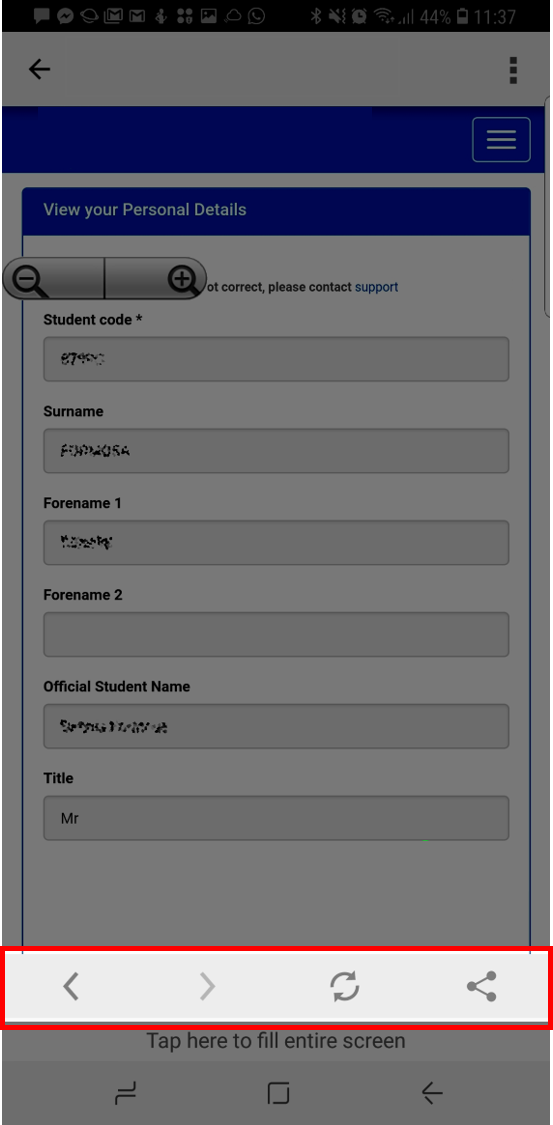
To improve the end user ‘seamless’ experience when linking to an external web page from the campusM Android App, we have provided an additional parameter to the campusM URL scheme that hides the navigation overlay that the Android operating system applies to the in-app browser (highlighted in the image).
The parameter noandroidtoolbar was added to the OpenURL scheme. If this is set to Y, then the toolbar will be hidden from the user, making the experience more seamless within the campusM App.
Calendar Data Refresh Fix and Enhancement
January 2019
We have modified the data refresh behavior for the timetable/calendar services to enhance your end users’ experience, whilst at the same time ensuring that the timetable data used to drive campusM Attendance is maintained even when the student doesn’t regularly review their timetable in app.
As of the January 2019 release, the Blended Timetable view will be updated within the campusM app when:
- The end user goes into the timetable screen (either blended timetable or the original timetable view) within the app during a session
- The end user pulls to refresh on the timetable screen in the app
- The end user goes into the app when the timetable data is considered ‘stale’, i.e. older than 72 hours by default. This default ‘stale’ time can be reduced to 24 hours on request.
iOS App Splash Screen Changes
January 2019
To enhance performance and improve reliability, we have embedded the loading splash screen within the iOS app build process, rather than as part of the configuration provided through the cloud on initial access. This will speed up initial load times and improve app resiliency in the case of a slow connection.
The splash screen is automatically generated using the app icon.
iOS 12 SDK Update
January 2019
As of the January 2019 release, all iOS apps are being built using the iOS 12 SDK, to ensure enhanced support for the new iOS devices such as the iOS XS Max.
Resolved Issues
- December 2019 iOS App / Android App / Web App
ATTENDANCE: Resolved an issue that resulted in multifactor validations (GPS and Crowdsource) being processed before the end of the class, potentially excluding crowdsource datapoint. HOTFIXED to November 2019 release. - December 2019 iOS App / Android App / Web App
ATTENDANCE: Resolved an issue that resulted in Crowdsource validation outcome overriding the GPS validation outcome when multifactor validation was set. HOTFIXED to November 2019 release. - December 2019 iOS App / Android App / Web App
ATTENDANCE: Resolved an issue that listed check-in transactions that included no iBeacon data being returned as SYNCED rather than "No beacons returned". HOTFIXED to November 2019 release. - December 2019 Android App
Resolved an issue where the timetable refresh did not occur on the first entry into the app, resulting in timetable data being updated only when entering the Timetable menu option. HOTFIXED to November 2019 release. - December 2019 Android App
ATTENDANCE: Resolved an issue that stopped the default endpoints from being changed from their defaults even though they were correctly modified on the Attendance Configuration page. HOTFIXED to November 2019 release. - December 2019 iOS App
ATTENDANCE: Resolved an issue that changes to or deletion of timetabled events where not being accurately reflected on the check-in pages. This could result in duplicate events being displayed or events not in the timetable appearing on the check-in pages. HOTFIXED to November 2019 release. - December 2019 iOS App / Android App / Web App
ATTENDANCE: Resolved an inconsistency in how the Attendance_Exclude flag was handled across the three platforms. The flag now ensures that events are visible on the check-in page, but the end-user is not asked to check in and the event status indicates that a check-in is not required. - December 2019 iOS App / Android App / Web App
Resolved an issue with Moodle Integration that prevented the integration from securely storing the authentication token and logging in. HOTFIXED to November 2019 release. - December2019 iOS App / Android App / Web AppSF: 00735236
Resolved an issue that crashed the app when re-authentication was required within the timetable pages. - December2019 iOS AppSF: 00733659 00738293
Resolved an issue that resulted in the app crashing when clicking on a menu option with the Recents overlay menu. - December2019 iOS AppSF: 00725385
Resolved an issue that prevented contact details being added to the devices contact list from the campusM person directory. - December2019 iOS AppSF: 00705015
Resolved an issue where the biometric login page buttons overlapped when the deice was flipped to horizontal view. - December2019 iOS AppSF: 00682673 00720088
Resolved an issue where the Menu Option title was not displayed in the header of the page when linking directly to an external Web page from a menu tile on the home page. - December2019 Web AppSF: 00718149
Resolved an issue that placed a blue border around the first alert record within the Web app when viewing the Alerts list. - December2019 Android AppSF: 00712434
Resolved an issue that prevented .mp4 videos from being rendered in the app browser. - December2019 Android AppSF: 00705017
Resolved an issue where end users were unable to scroll to read the end-user agreement when the device was flipped to horizontal view. - December2019 Android AppSF: 00647946
Resolved an issue that prevented users from downloading calendar files and adding them to their native calendar when it is linked to from the app. - November 2019 iOS App
Resolved an issue for customers who have SSO authentication enabled using CMAuth that created multiple calls to the IDP as part of the authentication process. This was related to the new Web view being enabled. HOTFIXED to October 2019 release. - November 2019 Android App
Resolved an issue for customers who have SSO authentication enabled using CMAuth that prevented the app from checking in or retrieving the check-in history. HOTFIXED to October 2019 release. - November 2019 iOSApp
Resolved an issue where timetable events were not updated correctly in the legacy Calendar View. HOTFIXED to October 2019 release. - November 2019 Android App
Resolved an issue that prevented multiple check-in to be conducted by the lecturer. HOTFIXED to October 2019 release. - November 2019 iOSApp SF: 00733789
Resolved an issue that prevented AEK screen titles from being shown when the new WebView is enabled. - November 2019 iOSApp SF: 00712433
Resolved an issue that stopped the back operation from working within multi-level AEK screens. - November 2019 Android App SF: 00712434
Resolved an issue that prevented MP4 videos from rendering within the in-app browser on Android devices. - November 2019 Android App SF: 00705018
Resolved an issue that prevented users from scrolling and accessing dates in their Timetable when they rotate the device from portrait to landscape. - November 2019 iOS App SF: 00705014
Resolved an issue on iPad devices where the Magnifying Glass icon for the search field is not aligned properly within Maps. - November 2019 iOS / Android App
Resolved an issue that prevented screen magnification being operated within AEK screens as part of the accessibility features enabled by the device Operating Systems. - November 2019 iOS / Android / Web App SF: 00718170
Resolved an issue that resulted in icon imagery not being rendered correctly in Creative Studio pages created via templates. - November 2019 Web App SF: 00718213
Enhanced the visibility of the alert title in the breadcrumbs and on the page itself when viewing sent alerts in the Web App with Portal Sidebar enabled. - November 2019 iOS App SF: 0060085
Resolved an issue that prevented Web pages opened within the campusM internal browser from rotating when the device was changed from portrait to landscape and vice versa. - November 2019 iOS / Android App SF: 00630116 00692336 00695783
Resolved an issue that prevented page titles from being captured in Insight Analytics when using an Action URL link within the app builder. - October 2019 iOS / Android / Web App
Resolved missing labels and navigation elements to enhance accessibility. Part of the WCAG AA 2.1 reaccreditation process. - October 2019 iOS SF: 00715658
Resolved an issue with the MazeMap integration that showed the browser navigation bar at the bottom of the map. - October 2019 iOS SF: 00712433
Resolved an issue with the onscreen navigation when using the new WebView. - October 2019 Android SF: 00712394
Resolved an issue that was affecting the Bluetooth settings on a device. - October 2019 Web App
Resolved issues relating to the breadcrumbs not displaying the correct trail or rendering incorrectly in the new Web Portal. - October 2019
Enhanced the error message shown when refreshing an AEK page when the device has no internet connection or cached data. - September 2019 iOS SF: 00708446
Resolved an issue on iOS where the AEK Native Microphone access was not working in the new WKWebView Web View. - September 2019 iOS SF: 00692234 00693062 00694848 00695748
Resolved an issue that prevented thecampusM App from opening external whitelisted apps on the user’s device when using the campusM URL Schema. - September 2019 Web App SF: 00671092
Resolved an issue where the ‘Received Alerts’ option disappears from the settings drop-down upon a page refresh. - September 2019 App Manager SF: 00644846
Resolved an issue in Creative Studio where semantic headings H1 – H3 were not available to be selected. - August 2019 iOS SF: 00688901
Columns in the timetable do not line up with their respective relevant days in the iPad Pro. - August 2019 Android SF: 00679978
Text labels on menu option tiles were not visible on some devices or for some selected text sizes. - August 2019 Android SF: 00671095 00685354
The app closed if the user pressed the volume up and down buttons. - August 2019 Android
The share to Facebook feature did not post a link to the app when posting to Facebook. - August 2019 iOS SF: 00692234 00693062 00694848 00695748
The user was not taken to the relevant App Store listing when selecting a link to a white listed app not yet installed on the user’s device. - July 2019 Android app SF: 00674684
Images and floorplans could not be zoomed in and out. An additional parameter was added to the URL scheme: noandroidtoolbar. If left as the default (N), then the toolbar for zooming images in Android appears. - July 2019 iOS app/ Android app/ Web App SF: 00591798 00655732
A Banner added through the App builder using an image stored within the Asset Manager failed to move off from the first Banner image added. - July 2019 Android SF: 00652167
The Dot notification badge did not clear after unread notifications received by the campusM app were reviewed and read. - June 2019 Android SF: 00643318
The Back button skips pages when clicked within an external page. - June 2019 Android SF: 00647946
Download files were broken when trying to download them from external websites. - June 2019 Android SF: 00565650
Pocket guide pages where not found once searched. - June 2019 Android SF: 00502185 00655294
Aligned Android experience with iOS when position belongs to more than one category to display the category in addition to the position itself. - May 2019 App Manager SF: 00563271 00573670
The "clear all" option in alert group subscriptions did not remove all the subscribers in the alert group when more than 200 users were in the group. - May 2019 App Manager SF: 00651672
There was an issue in notification subscription groups when trying to add users for groups with more than 200 users. - May 2019 Web app SF: 00613997
The wrong device model was submitted as part of the feedback when sent from an Edge browser. - April 2019 Android app
When PC Availability is configured for more than one language, there were cases were the position data wasn’t translated. - April 2019 iOS app / Android app / Web app SF: 00540146
Custom text configuration for Facebook sharing didn’t display on the app. - April 2019 Android app SF: 00541524
Google rejected apps due to background play for YouTube videos. We implemented a fix that pauses the videos while in the background. - March 2019 iOS app
Some Pocket Guide pages/content created in Creative Studio was cached locally on the iOS app (meaning it was not available offline for the end user, even if they have visit the pocket guide page previously). - March 2019 iOS app
Re-logging into as SSO profile and then refreshing timetable caused the app to crash. - March 2019 Android app SF: 00631569
The next class to check in to was not shown in the original campusM Attendance module. - March 2019 Android app SF: 00611190 00617302 00618701 00626533
PDFs were not opened within the in-app browser. - March 2019 Android app SF: 00613616
Client-side files (such as photos) could not be selected and uploaded via the in-app browser. - March 2019 iOS app SF: 00588405
Some iOS devices had rendering issues when moving from integrations or pocket guide pages in landscape orientation and returning to the home screen. - February 2019 Android App SF: 00631569
Some Attendance event data was not shown correctly in the user interface, resulting in upcoming events not visible to the end-user. - February 2019 Android App SF: 00607709
The campusM Android App crashed when parsing parameters using the campusM URL schema for AEK. - February 2019 Android App SF: 00622597
Rotating the screen from Portrait to Landscape when on an SSO authentication screen removed the entered credentials and the end-user was reprompted. - February 2019 Android App SF: 00622599
Removed the Zoom buttons from in App browser when linking to an external page within the campusM Android App. - February 2019 iOS app / Android App SF: 00513485 00577302 00618683
A loading spinner was left on the screen when linking to a webpage within AEK. New parameters (hideLoadingSpinner and cm_hide_loading_spinner) were added to the openURL and postURL campusM URL schema (respectively). - February 2019 iOS app SF: 00475931 00563745
The app crashed when an end-user switched from a guest profile to an authenticated profile within a profile group. - February 2019 App Manager
App Manager navigation icons were not all shown on low resolution screens (such as a laptop) when attempting to access using the quick access drop down interface./li> - January 2019 Android App SF: 00622606
There was no padding around the app icon and the menu title within screens such as App Settings in Android. A 5-pixel padding was added to ensure visual separation. - January 2019 iOS App / Android App SF: 00607582 00610596 00613588 00617305 00618658 00618863
The timetable data was not automatically updating when entering the timetable screens with blended calendar enabled. See Calendar Data Refresh Fix and Enhancement, above. - January 2019 App Manager SF: 00601139 00602039
Bin Alerts were not being sent in a timely fashion for local council customers. - January 2019 App Manager SF: 00554122
Added missing translation keys within the personalization interface that had resulted in untranslated interface cues.


